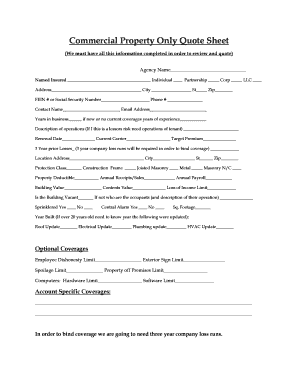Fill and Sign the Commercial Quote Sheet Form

Useful suggestions for finishing your ‘Commercial Quote Sheet’ digitally
Are you exhausted by the burden of managing documents? Look no further than airSlate SignNow, the leading eSignature platform for individuals and organizations. Bid farewell to the tedious steps of printing and scanning papers. With airSlate SignNow, you can effortlessly complete and endorse documents online. Take advantage of the robust features embedded in this user-friendly and economical platform and transform your methodology to document handling. Whether you need to sign documents or collect eSignatures, airSlate SignNow manages everything seamlessly, requiring merely a few clicks.
Follow this comprehensive tutorial:
- Access your account or initiate a free trial with our service.
- Click +Create to upload a file from your device, cloud storage, or our form library.
- Open your ‘Commercial Quote Sheet’ in the editor.
- Click Me (Fill Out Now) to finalize the form on your part.
- Add and designate fillable fields for others (if necessary).
- Continue with the Send Invite settings to solicit eSignatures from others.
- Save, print your copy, or convert it into a reusable template.
Don’t fret if you need to work with your coworkers on your Commercial Quote Sheet or send it for notarization—our platform provides everything necessary to accomplish such tasks. Establish an account with airSlate SignNow today and take your document management to new levels!
FAQs
-
What is a Commercial Quote Sheet and how can it benefit my business?
A Commercial Quote Sheet is a document that outlines pricing and terms for products or services offered to clients. Using a Commercial Quote Sheet helps streamline the quoting process, ensuring accuracy and consistency in your pricing. By implementing this tool, your business can enhance customer communication and increase conversion rates.
-
How does airSlate SignNow simplify the creation of a Commercial Quote Sheet?
airSlate SignNow provides an intuitive interface that allows users to easily create and customize Commercial Quote Sheets. With our drag-and-drop functionality, you can add fields, logos, and terms to your quote sheet quickly. This ease of use saves time and reduces errors, enabling you to focus on closing deals.
-
Can I integrate airSlate SignNow with my existing CRM for Commercial Quote Sheets?
Yes, airSlate SignNow offers seamless integrations with popular CRM systems. This means you can automatically generate and send Commercial Quote Sheets directly from your CRM, streamlining your workflow. Integrating our solution enhances efficiency and ensures that your sales team has the tools they need at their fingertips.
-
What features does airSlate SignNow offer for managing Commercial Quote Sheets?
airSlate SignNow includes features such as electronic signatures, customizable templates, and real-time tracking for Commercial Quote Sheets. These tools allow you to manage the entire quoting process, from creation to signing. Additionally, you can store all your documents securely in the cloud, making them easily accessible anytime.
-
Is airSlate SignNow suitable for small businesses needing Commercial Quote Sheets?
Absolutely! airSlate SignNow is designed to be cost-effective and accessible for businesses of all sizes, including small businesses. Our solution provides the necessary features to create and manage Commercial Quote Sheets without breaking the bank, making it an ideal choice for startups and growing companies.
-
How can I ensure the security of my Commercial Quote Sheets with airSlate SignNow?
airSlate SignNow prioritizes security with advanced encryption and compliance with industry standards. Your Commercial Quote Sheets are stored securely and can only be accessed by authorized users, ensuring that sensitive information remains protected. You can also track who viewed or signed your documents for added peace of mind.
-
What are the pricing options for airSlate SignNow when using Commercial Quote Sheets?
airSlate SignNow offers flexible pricing plans tailored to meet the needs of various businesses. You can choose from a range of plans that allow you to create and manage unlimited Commercial Quote Sheets based on your requirements. Our transparent pricing structure ensures you get the best value for your investment.
Related searches to commercial quote sheet form
Find out other commercial quote sheet form
- Close deals faster
- Improve productivity
- Delight customers
- Increase revenue
- Save time & money
- Reduce payment cycles

